Saturday, January 24, 2004
Billon antoninianus, Gallienus, Colonia Agrippina, Göbl 872m
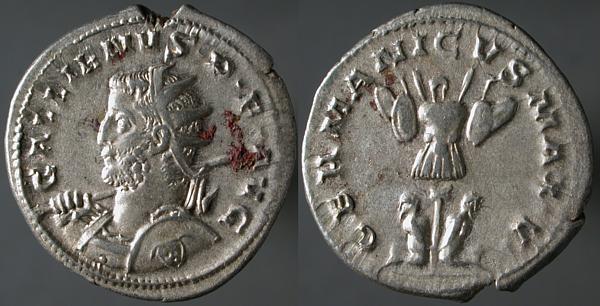
GALLIENVS P F AVG, Radiate cuirassed bust left with decorated shield on near shoulder and spear on far | GERMANICVS MAX V, Two captives seated at the foot of a trophy, their arms tied behind their backs. Colonia Agrippina later had its name shortened to Köln.
Nice triumphant image, celebrating one in a series of victories against always troublesome invaders. I'm not clear on what the decoration on the shield is.
Friday, January 23, 2004
Æ26, Cyzikus in Mysia, mid-3rd C., SNG von Aulock 7366var
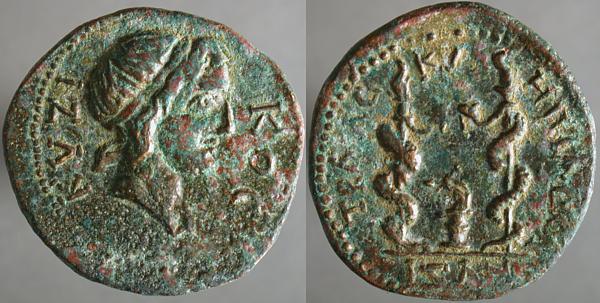
ΚVZΙ_ΚΟC, Laureate head of Kyzikos right | CΤΡΑ ΑC_ΚΛ_ΗΠΙΑ[CΟΝ?] ΚVΖΙ, Flaming altar between two snake-entwined flaming torches.
A slightly different version of the coin I posted on Tuesday, naming another strategos, (Asklepios?) and displaying the same attractive mottled red and green patina as many of my Cyzikus provincials. I suspect that many of the so mottled coins were retrieved from the same place at the same time, though I purchased them from different dealers over a span of years.
Thursday, January 22, 2004
Æ sestertius, Valerian, Rome, Göbl 40h
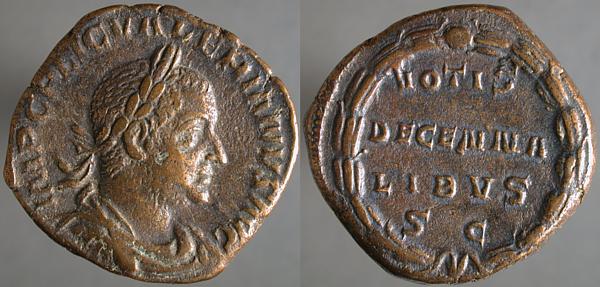
IMP C P LIC VALERIANVS AVG, Laureate draped cuirassed bust right | VOTIS / DECENNA / LIBVS / S_C, Legend in four lines within wreath.
The reverse legend expresses Valerian's vows to the gods on the occasion of his tenth anniversary in office. Since he was captured by Shapur, and died, after being in office for about seven years, we can view the coin as being issued optimistically, expressing intent rather than deed.
This is quite a nice example of a mid-3rd century sestertius: all of the obverse legend except the tops of a few letters is on the roundish flan, as is the wreath on the reverse, major details are all clear, and if it weren't for some previous owner having cleaned off every trace of patina it'd almost certainly be beyond my means. If all goes well, in another 10 or 15 centuries it should be quite valuable.
Wednesday, January 21, 2004
AR denarius, Roman Republic, 110/109 BCE, brockage of RSC Claudia 2
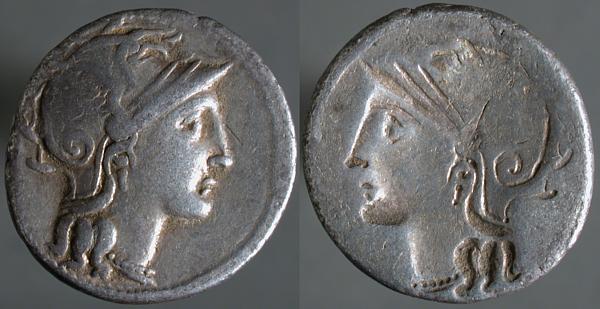
Brockages, produced when a coin is struck by another coin stuck to a die, rather than by the die itself, provide grounds for some speculation about the operation of ancient mints. There's a good page on brockages and die clashes by Doug Smith here and a photo of a normal version of the coin here.
My speculation is that, in this case, the punch die had become uncomfortably hot and was set aside and a cooler die taken up. When that die became hot the original die, with the unseen coin still stuck to it, was taken up and this coin was struck. The stuck coin had hardened enough while cooling that it was able to transfer a great deal of detail to the blank, which was soft from being heated.
Tuesday, January 20, 2004
Æ26, Cyzikus in Mysia, mid-3rd C., SNG von Aulock 7366var
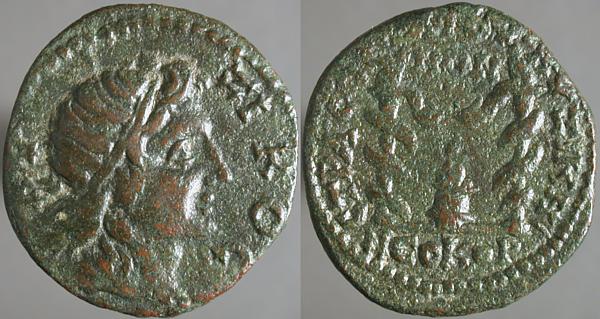
Κ[V]_ΖΙΚΟC, Laureate head of Kyzikos right, star behind | CΤΡΑ CΩCΤ[ΡΑΟΥ] ΚΥΖΙΚΕΩΝ / ΝΩΝ / ΝΕΟΚΟΡ, Flaming altar between two snake-entwined flaming torches.
A quasi-autonomous coin from circa the time of Valerian and Gallienus, featuring the same reverse, and apparently the same strategos, Sostratos, as the Valerian coin I posted on Sunday.
Prior to Roman domination, Strategos had meant General, but by this time it was merely a title for a local magistrate, involving no command of troops. Navarchis, the title for Admiral, underwent a similar evolution.
Monday, January 19, 2004
Billon antoninianus, Gallienus, Antioch, Göbl 1632i
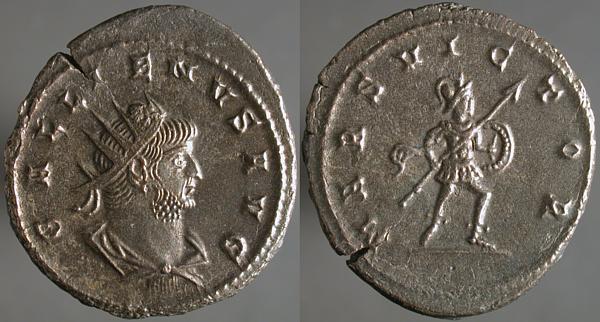
GALLIENVS AVG, Radiate draped cuirassed bust right | MARS VICTOR, Mars advancing right, crouching slightly, wearing helmet, carrying spear and shield.
I like this one for its excellent condition, particularly the clear definition of the shield that Mars is carrying. High-grade late-reign coins of Antioch seem to be readily available, which suggests that they didn't circulate for long. It may be that, as new issues were continually debased further and further, a coin didn't get old before it was of noticeably better metal than new ones, and worth hoarding.
Sunday, January 18, 2004
Æ26, Cyzikus in Mysia, Valerian, SNG Cop 143var
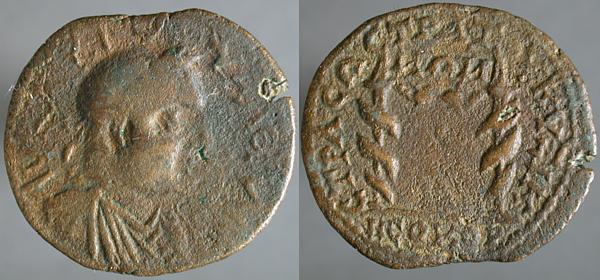
ΑV[...]VΑΛΕ[...], Laureate draped bust right | CΤΡΑ CΩCΤΡΑΟΥ ΚΥΖΙΚΕΩΝ / ΝΩΝ / ΝΕΟΚΟΡ, Flaming altar between two snake-entwined flaming torches.
I'll post some better versions of this reverse, where that altar between the torches is more visible, in the next week. It shows up frequently enough at Cyzikus that it must have some specific local significance, but I don't think we know what that was, beyond the general association of Salus and snakes.

